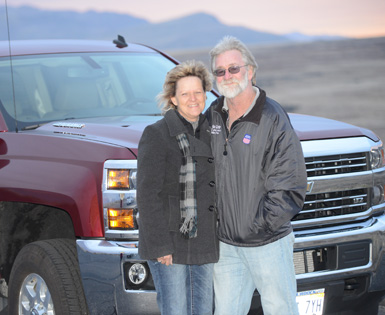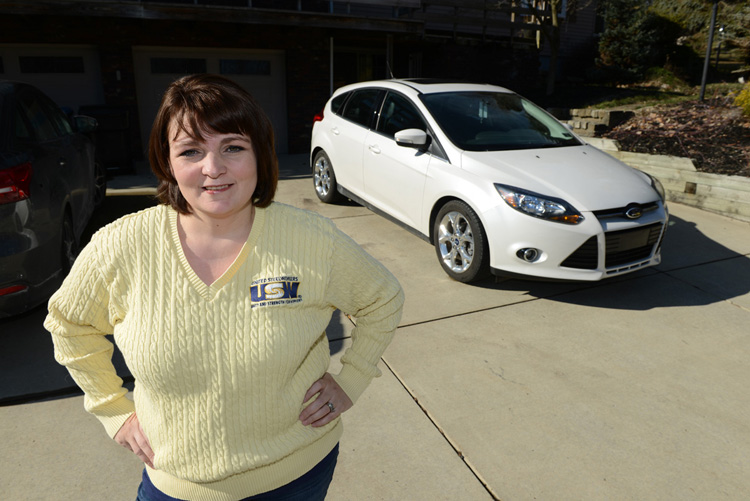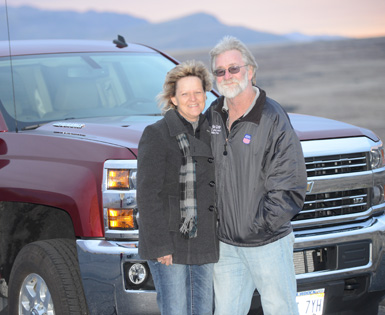Top 10 Union-Made Vehicles Union Members Buy
- Chevy Equinox
The Chevy Equinox is considered a family friendly SUV for its roomy interior. This well-equipped ride is perfect for all your summer, winter, spring and fall road trips.
- Chevy Silverado
Like its competitors, the Chevy Silverado is a master at the haul, tow and carry routine. But this pickup goes miles ahead of most by sporting a ton of configuration options and hi-tech features.
- Ford F-150
If you’re in the market for a pickup, this workhorse won’t disappoint. It also has a reputation for speed and hi-tech functionality. In fact, the Ford F-series pickup trucks have been the bestselling vehicles in America for decades! That’s quite a distinction.
- Jeep Cherokee
They say variety is the spice of life, and with the Jeep Cherokee, there are several different varieties to choose from. So, spice things up from sporty to luxury with this popular SUV.
- Jeep Grand Cherokee
Purpose-built luxury is Jeep’s claim for this modern and elegant SUV. But even with a grand dose of stylish design, the Grand Cherokee still upholds Jeep’s reputation for a sturdy and powerful vehicle that exudes confidence in every way.
- Ford Escape
A compact crossover with great looks inside and out, the Ford Escape is also popular for practical features like generous cargo space and gas mileage.
- Chevy Cruze
This little go getter has something for everyone. It’s sporty and hi-tech for the young-at-heart; compact for the city driver; gets great mileage for the commuter; and low-priced for the multi-car household looking for savings.
- Chevy Traverse
As one of the newest SUVs on the market, the Chevy Traverse makes a name for itself with the features of a full-size (seats 8) and the pricing of a compact.
- Dodge Ram 1500
The Ram 1500 packs a mean punch both visually and with its horsepower and towing capabilities. But with the air suspension to improve handling, this fierce pickup easily offers the most comfortable ride.
- Chevy Malibu
More into the mid-size vehicles? The Chevy Malibu might be your speed. Fun fact: the car was named after the city in California.
See More Union Made Vehicles Search for Union-made vehicles


Union members love union-made vehicles because they are affordable, well-made and purchasing union-made supports the domestic auto industry. Here’s a list of the Union Plus Auto Buying program’s top ten bestsellers likely to rev your engines!
Today’s Drivers. Tomorrow’s Features.
Safety is often cited as a top priority among car buyers and rightfully so, considering automotive fatalities have increased in recent years and continue to result in over 30,000 deaths per year. To date, automotive fatalities are the number one cause of accidental deaths in the USA. As grim as those truths are, there is a bright side. Automakers continue to develop technologies that minimize danger to drivers, occupants and pedestrians every year. In fact, the National Highway Transportation & Safety Agency (NHTSA) is exploring changes to the New Car Assessment Program (Star Ratings) to address the rapid developments in vehicle technology, especially in the area of crash avoidance.
As safety technology improves, it means that new vehicles today often have more safety equipment than the most advanced vehicles from 10 years ago.
Overwhelmed or confused about what safety systems are out there and how they work? We’ve put together a list of key safety technologies for you to consider during your next vehicle purchase.
Blind Spot Monitor
We love Blind Spot Monitor systems because the technology is remarkably easy to use, and something we interact with nearly every time we get behind the wheel. When another vehicle is traveling alongside you and is a bit too close for comfort, a notification light will turn on letting you know that it’s unsafe to change lanes. These notifications are often found on the side view mirrors, but we prefer applications where the warning lamps are on the inside of the car within the line of sight of the mirror. This eliminates any obstruction due to moisture, dirt or snow. Some automakers are now including notifications in the Heads Up Display that projects onto your windshield, so a driver doesn’t even need to turn his/her head to know if a vehicle is in the blind spot.
Automatic Emergency Braking (AEB)
AEB combines multiple technologies to minimize or eliminate collisions. While the technology was first used in applications for vehicles traveling forward, the technology has been applied to prevent crashes while traveling backwards. Sensors in the vehicle calculate vehicle speed against required stopping distance and applies the brake when a collision is imminent or likely. The system alerts the driver, pre-charges the brakes and, if necessary, automatically applies the brakes in rapid succession. Often, AEB works with seatbelt pretensioners that retract the seatbelt, holding occupants snugly in place to reduce injuries that may occur from a collision. Many automotive safety experts believe that AEB is the single most valuable technology available today to reduce the traffic accidents on the road.
Surround View Cameras
Starting in 2018, all new vehicles in the US will be mandated to come equipped with a rear-view camera. This is in response to an incident in 2002 where a child was tragically killed when a driver was unable to see them as they backed out of a driveway. While danger of injury to pedestrians located on the side or in front of the car is less likely, surround view monitors provide a 360 degree, overhead view of the area surrounding your vehicle. This helps keep your car safe too, reducing the likelihood of dents and scrapes while negotiating tight parking spots or alleyways.
Lane Keep Assist
While fully self-driving vehicles are still years away, we can already enjoy the benefits of this emerging technology today. Semi-autonomous driving systems use sophisticated sensors to detect traffic lanes and vehicle surroundings. These sensors enable the vehicle to control speed, distance between vehicles and steer within a lane. Some vehicles now offer the ability to change lanes automatically as well. These systems are not designed to completely take over control of the vehicle, and require consistent monitoring from the driver (or the system will shut off). While the systems don’t allow for drivers to be inattentive, they help reduce driver fatigue over long hauls and assist the driver in maintaining awareness of driving conditions.
Lane Departure Warning
A step below Lane Keep Assist systems is Lane Departure Warnings. While these systems don’t actively steer the vehicle, they detect traffic lanes and alert the driver to any drifting outside of those lanes. The alerts vary from audible chimes, to visual cues, to haptic seat feedback, to a slight nudge from the steering wheel to get you back on track.
Cross Traffic Alert
Nearly every driver has experienced pulling out of a driveway or parking spot at the mall and had their heart skip a beat as a car goes whizzing by. Rear Cross Traffic Alert systems act as a spotter to oncoming traffic that can be difficult or impossible to see. The system is often integrated with rear camera monitors and can also indicate which direction the traffic is coming from. The haptic seat feedback systems that give your seat a buzz rather than audible chimes assure only the driver is alerted.
Driver Awareness / Heads Up Display / Voice Recognition
We are bundling a variety of emerging technologies into a category that minimizes driver distractions. Heads up displays project an image onto the windshield, just above the steering wheel, in a driver’s line of sight and provide a snapshot of relevant data like vehicle speed and navigation instructions. Voice recognition allows for common functions like temperature settings and audio playback. And driver awareness monitors driver inputs from the steering wheel and throttle; in some cases, it watches your eyes to detect drowsiness or lack of attention. These features are designed to make sure your eyes stay on the road, your hands stay on the wheel, and your attention stays focused on arriving to your destination safely.
SOS Services
If an accident occurs, many vehicles now offer post-accident emergency services to automatically dial 911 and send help. These telematics systems may require a cell phone to be paired to your vehicle or a subscription to an automaker supplied service, so be sure to talk to your local TrueCar dealer to ensure that you are set up to take advantage of all the safety systems available on your vehicle.
Rear Seat Occupant Warning (GM)
In 2014, over 30 children died from heatstroke after being left in a vehicle. In an effort to prevent further tragedies, General Motors introduced a feature that would alert the driver with an audible alarm, typically using the horn to notify the driver that they may have left an item in the rear seat of the vehicle. The technology uses a simple logic to perform this check. If a driver opens a rear door, enters the driver’s seat, exists the vehicle and doesn’t open the rear door again, the vehicle will trigger an audible alert.


See which car features are most notable for the current market.
Top Ten Summer Road Trip Tips
-
Tend to your tires.
Check your tire pressure - and check it often. Also, make sure that you have season-appropriate tires on your car. Use your union member Union Plus Goodyear Coupon for car tune-ups and new tires, including union-made tires. -
Stay on top of your fluids.
Oil and coolant are the two key fluids during the summer months to keep your car cool and running smoothly. And in the winter, anti-freeze is a key fluid to monitor. -
Give the rest of your car a once-over.
Check the battery, belts, and hoses or have a mechanic do so before you head off on that cross country trip. Also, make sure your wipers are ready and don't forget your windshield wiper fluid. -
Prepare an emergency kit for your car.
Keep the number of Union Plus Motor Club - 24 Hour Emergency Automotive Roadside Assistance Plan handy. -
Pack smart.
Keep snacks, drinks, and sandwiches handy. -
Load smart.
Don't block your view with a backseat piled high and keep the weight even for maximum handling. -
Stay awake.
Switch drivers every few hours even if you don't think you are tired. -
Be careful when you tow.
Check your owner's manual to make sure your vehicle is properly equipped to handle a trailer hitch for towing campers or trailers, and that it can handle the weight. -
Take the scenic route.
Give yourself time to enjoy the ride. -
Be nice.
Use your signals. Let faster drivers pass. Don't tailgate. Share: it's not your road.

Planning a road trip this summer? Before you hit the road, make sure you check out these top 10 tips to ensure your travel is safe, fun and stress-free!


Take Care of Your Baby with Union Plus Auto Insurance
*Savings based on our 2016 countrywide research of new call center customers’ annual average savings in 2015.
**Delay is not automatic. Certain restrictions apply. Policyholder must request delay of payment by calling 1-800-GETMET8. Delayed premium payment is expected when hold is lifted. 1 See policy for restrictions. Not available in all states. 2 Not available in all states. In NY, drivers must pay a state-required minimum deductible before using this benefit. MetLife Auto & Home is a brand of Metropolitan Property and Casualty Insurance Company and its affiliates: Economy Preferred Insurance Company, Metropolitan Casualty Insurance Company, Metropolitan Direct Property and Casualty Insurance Company (CA Certified of Authority: 6730; Warwick, RI) Metropolitan General Insurance Company, Metropolitan Group Property and Casualty Insurance Company (CA COA: 6393; Warwick, RI), and Metropolitan Lloyds Insurance Company of Texas, all with administrative home offices in Warwick, RI. Coverage, rates, discounts, and policy features vary by state and product, and are available in most states to those who qualify. Met P&C®, MetCasSM, and MetGenSM, are licensed in MN.
© 2018 MetLife Auto & Home
L0118501934[exp1220][All States][DC]
When you’re ready to protect your vehicle from fender to bumper, look to Union Plus Auto Insurance provided through MetLife Auto & Home®. Check out this video to see what the program has to offer you.
Find Your Perfect Vehicle Match with Union Plus
* Between 7/1/16 and 9/30/16, the average estimated savings off MSRP presented by TrueCar Certified Dealers to users of TrueCar powered websites, based on users who configured virtual vehicles and who TrueCar identified as purchasing a new vehicle of the same make and model listed on the certificate from a Certified Dealer as of 10/31/2016, was $3,106. Your actual savings may vary based on multiple factors including the vehicle you select, region, dealer, and applicable vehicle specific manufacturer incentives which are subject to change. The Manufacturer's Suggested Retail Price ("MSRP") is determined by the manufacturer, and may not reflect the price at which vehicles are generally sold in the dealer's trade area as not all vehicles are sold at MSRP. Each dealer sets its own pricing. Your actual purchase price is negotiated between you and the dealer. TrueCar does not sell or lease motor vehicles.
**EPA Green Car Make and Models Include:
- Chevrolet — Cruze, Cruze Diesel, Malibu and Sonic
- Chrysler — 200
- Ford — Focus and C-Max
Searching for a new vehicle can be overwhelming! So get some free help finding the right new or used car or truck for you and your family. Check out this video to see what the Union Plus Auto Buying Service, administered by TrueCar™, has to offer you.
The Data Behind the Best Times to Buy a New Car
Car prices change all the time, for all kinds of reasons. Using industry sales data from previous years, the experts at TrueCar identified the best times to buy a new car by month, day and even segment.



TrueCar, which powers the Union Plus Auto Buying Service, has analyzed more than 12 million transactions over five years to determine which day of the year is the best to buy a vehicle. The savings can be huge!

BMWED Member Gets Great Deal with the Union Plus Auto Buying Service
If you’ve traversed a railroad bridge or tunnel in Nevada or Wyoming, Rex Cutler could probably name it. The lifetime Brotherhood of Maintenance of Way Employees (BMWED) Local 1227 member did the heavy lifting on the cornerstones of rail infrastructure in both states. Now in retirement and thanks to Union Plus, he’s fully prepared to hit the open road along with his wife, Dawn.
Rex and Dawn are proud owners of a 40-foot trailer that’s meant to fulfill their wanderlust. However, they felt like there was one hitch in their plan – they needed more horsepower underneath the hood than their previous vehicle could muster.
“With that trailer, we intend to camp a lot more. We made up our minds that to do it right, we needed a more powerful vehicle,” said Dawn Cutler, the family’s chief car buying officer.
Doing it right meant the Ogden, Utah, couple sought a perfect deal on a full-bed diesel truck, hopefully in maroon. Rex and Dawn began the process by visiting the same dealership where they had purchased every car since 1989.
“We went in and tried to negotiate a good price based in our loyalty to the dealership,” said Cutler. “Unfortunately, there just wasn’t a deal there. We walked out. I told Rex that I’d search online and that’s when I remembered the Union Plus Auto Buying Service.”
Dawn confirmed they were eligible for the Union Plus Auto Buying Service, which saves BMWED members an average of more than $3,106 off MSRP on new vehicles. For used vehicle purchases, Union Plus offers up to $1,000 in discounts and often can provide free CarFax reports throughout the buying process. Additionally, the Cutlers were eligible for a $100 rebate since they were purchasing a new, union-made vehicle*.
“Originally, when we signed up for the service, I didn’t even know we were eligible for the rebate,” said Cutler. “It had all gone so smoothly. Suddenly we had a variety of competing prices to choose from. We got a great deal. Then lo and behold, a little while later, a check arrived. We were shocked. It’s such an excellent service.”
The Cutlers put their new ride right to work, pulling their trailer to the Idaho wilderness, and exploring the scenic wonders of southern Utah. They’ve found that having a huskier engine and more capacity enables them to travel with ease.
The Union Plus Auto Buying Service is available in the United States for active and retired union members, and their families. This program connects Union Plus buyers with certified dealers who offer upfront, online pricing, and Guaranteed Savings. It also provides insight into what others paid for the same car so you have the confidence that you’re getting a great deal.
*Between 7/1/16 and 9/30/16, the average estimated savings off MSRP presented by TrueCar Certified Dealers to users of TrueCar powered websites, based on users who configured virtual vehicles and who TrueCar identified as purchasing a new vehicle of the same make and model listed on the certificate from a Certified Dealer as of 10/31/2016, was $3,106. Your actual savings may vary based on multiple factors including the vehicle you select, region, dealer, and applicable vehicle specific manufacturer incentives which are subject to change. The Manufacturer's Suggested Retail Price ("MSRP") is determined by the manufacturer, and may not reflect the price at which vehicles are generally sold in the dealer's trade area as not all vehicles are sold at MSRP. Each dealer sets its own pricing. Your actual purchase price is negotiated between you and the dealer. TrueCar does not sell or lease motor vehicles.
TrueCar operates this information website ("Service") featuring pricing, performance, technical, and safety data available for new and used vehicles. The Service is not available in all locations.
**Guaranteed Savings not available in all states. In these states, a Target Price is shown, which is a market-based example of what you can reasonably expect to pay for your vehicle as configured. Your configured vehicle may not be available or in-stock at the Certified Dealer.
TrueCar does not broker, sell or lease motor vehicles. Each Certified Dealer sets its own pricing, and will confirm actual vehicle availability from in-stock inventory, including options and color choices.


Read how this Brotherhood of Maintenance of Way Employees (BMWED) member shifts from the railroad to the open road through the Union Plus Auto Buying Service.

Why Do Car Prices Change?
The Union Plus Auto Buying Service is committed to a faster, easier buying experience. One part of the process you may be wondering about is the tendency for car prices to change. The simple answer is supply and demand.
The base price or manufacturer suggested retail price (MSRP) of a particular car does not fluctuate much. But to meet or drive changes in demand, manufacturers often offer incentives such as cash back or bonus cash. Dealers have the same opportunities to offer incentives based on their stock, which often happens towards the end of the month.
For example, one dealership might project high sales of a popular model. A smaller dealership in a different city doesn’t, requesting fewer vehicles from the manufacturer. This second dealer might not offer incentives because they believe their smaller inventory will sell, while the first offers them to quickly move more vehicles.
While prices fluctuate, using a platform like the Union Plus Auto Buying Service, you can receive upfront pricing information from participating dealers that includes available dealer and manufacturer incentives. The Union Plus Auto Buying Service uses TrueCar Certified Dealers who will help you find the vehicle you want and locate incentives you may qualify for, including potential extra savings.


We want to empower consumers with the information they need to feel confident throughout the entire car-buying process. Knowing why car prices change will help you get a great deal.

Union Plus Helps USW Employee Get Great Deal on New Union-Made Vehicle
Lisa Nutter started in the purchasing and travel department at the United Steelworkers headquarters (USW) in Pittsburgh, PA six years ago. She made a career move from the corporate world because she wanted to experience the benefits that union membership offers. She loves that the union is always looking out for her and her fellow union members’ best interests. Another value that comes with union membership is the opportunity to take advantage of the Union Plus member benefits.
“I was at a local USW meeting and someone mentioned Union Plus to me,” Nutter, a USW Local 3657 member, said. “I started looking through their website. I saw discounts for theme parks and purchased tickets to Universal Studios in Florida. I then saw a page on the Union Plus Auto Buying Service, and the next thing you know I was buying a new union-made car.”
Nutter, who serves as the recording secretary in her local, used the Union Plus Auto Buying Service to purchase her new Ford Focus hatchback. Through the Union Plus website, it is easy to search for a new or used car you want within a radius of your house, and then see the dealer price for that car. Administered by TrueCar, the Union Plus Auto Buying program ensures that union members are getting the best price on the car they want.
“I found the whole program to be a very seamless process,” Nutter said.
“Union Plus gave me two dealerships to look at and one dealership contacted me right away. They had worked with Union Plus before, and I didn’t have to do any negotiating. This is the first brand new car I have ever owned; it only had four miles on it when I purchased it!” Nutter said.
The Union Plus Auto Buying Service helps union members and their families save an average of $3,279 off MSRP. It allows members to see what others paid for the same model car you want and lock in the price. Union members can also get a $100 rebate when you they buy a new union-made car and $200 on a new union-made, EPA Green car1.
“One of the coolest things about my new Focus is that it has a sticker on it saying that it was made in a union plant; that’s very cool to look at,” Nutter added.
“Union Plus is a great thing for union members. I like to know that the benefits of being in my local union extend beyond the local. It’s great being recognized on a grander scale for being a union member," Nutter said.
1Between 7/1/15 and 9/30/15, the average estimated savings off MSRP presented by TrueCar Certified Dealers to users of TrueCar powered websites, based on users who configured virtual vehicles and who TrueCar identified as purchasing a new vehicle of the same make and model listed on the certificate from a Certified Dealer as of 10/31/2015, was $3,279. Your actual savings may vary based on multiple factors including the vehicle you select, region, dealer, and applicable vehicle specific manufacturer incentives which are subject to change. The Manufacturer's Suggested Retail Price ("MSRP") is determined by the manufacturer, and may not reflect the price at which vehicles are generally sold in the dealer's trade area as not all vehicles are sold at MSRP. Each dealer sets its own pricing. Neither TrueCar nor Union Plus brokers,sells or leases motor vehicles.
TrueCar operates this information website ("Service") featuring pricing, performance, technical, and safety data available for new and used vehicles. The Service is not available in all locations.
**Guaranteed Savings not available in all states. In these states, a Target Price is shown, which is a market-based example of what you can reasonably expect to pay for your vehicle as configured. Your configured vehicle may not be available or in-stock at the Certified Dealer.
TrueCar does not broker, sell or lease motor vehicles. Each Certified Dealer sets its own pricing, and will confirm actual vehicle availability from in-stock inventory, including options and color choices.


Read how this United Steelworkers (USW) International headquarters employee purchases her first new car thanks to the Union Plus Auto Buying Service.

How to Avoid Buying a Lemon Car
Finding a trouble-free used car has nothing to do with luck and everything to do with applying good research and investigative skills. Knowing how to spot potential problems and determining how reliable a used vehicle is can save you from expensive automotive headaches down the road. The following advice can help you determine whether a used vehicle is a good value or potential trouble.
13 Tricks to Try
- Check the Reliability Record
A good way to reduce the risk of purchasing a trouble-prone vehicle is to select models with a good reliability record before you begin shopping. Consumer Reports' annual subscriber survey provides exclusive real-world reliability information that can help you narrow your selections. See best and worst used cars for a quick-reference list of the best and worst used cars from our most recent survey. Also read the reliability-history charts that accompany most of Consumer Reports' vehicle profiles to get a more detailed view at how specific models have held up in 17 trouble areas as well as overall.
- Read the Window Sticker
The Federal Trade Commission requires dealers to post a Buyer's Guide in every used vehicle offered for sale. Usually attached to a window, it must contain certain information, including whether the vehicle is being sold "as is" or with a warranty, and what percentage of repair costs (if any) the dealer is obligated to pay. The Buyer's Guide information overrides any contrary provisions in your sales contract. In other words, if the Buyer's Guide says that the vehicle is covered by a warranty, the dealer must honor that warranty. If any changes in coverage are negotiated, the Buyer's Guide must be altered to reflect them before the sale.
If a sale is designated "as is," it means that the dealer makes no guarantees as to the condition of the vehicle, so any problems that arise after you have made the purchase will be your responsibility. Many states do not allow as-is sales on vehicles selling for more than a certain price.
- Check the Exterior
Begin by doing a walk around of the car, looking for dents, chipped paint, mismatched body panels or parts, broken lamp housings, and chipped windows. Gaps between body panels should be of a consistent width and line up.
A closer inspection can reveal paint overspray on chrome or rubber trim or in the vehicle's wheel wells. This is a telltale sign of body-panel repair.
Test for the presence of body filler with a small magnet. If the magnet doesn't stick to the panel, the car may have filler under the paint (some vehicles with plastic or fiberglass panels, however, won't attract a magnet at all). A door, hood, or trunk that doesn't close and seal properly is evidence of previous damage and/or sloppy repair work. A CAPA (Certified Automotive Parts Association) sticker on a body panel means the part has been replaced. Inconsistent welds around the hood, doors, or trunk also indicate repair.
- Check the Interior

A long look into the cabin can reveal many obvious problems, such as a sagging headliner, cracked dashboard, and missing knobs, handles, and buttons. Frayed seat belts or ones with melted fibers (because of friction) may be evidence of a previous frontal impact above 15 mph--damaged safety belts should always be replaced.
Prematurely worn pedals or a sagging driver's seat are signs that the vehicle has very high mileage. An air bag warning light that stays lit may indicate that a bag has deployed and been improperly replaced--or not replaced at all. A mildew smell, caused by a water leak, can be very hard to get rid of. Discolored carpeting, silt in the trunk, or intermittent electrical problems may be signs of flood damage.
- Check Under the Hood
At first glance, the engine, radiator, and battery should be relatively grease-free and have very little or no corrosion. Belts and hoses should be pliable and unworn. Look for wet spots, which can indicate leaking oil or fluids. Melted wires, tubes, or lines, or a blackened firewall may be signs of overheating or even an engine fire.
With the engine cool, insure that all fluids are clean, filled to the proper level, and do not have leaks. Check the engine oil while the engine is cool. Remove the dipstick from its tube and clean it with a dry rag, reinsert it and remove it again. The oil level should be between the "full" and "add" marks. Normal engine oil is brown or black, depending on when it was last changed. Gritty or gelatinous oil may indicate long stretches between oil changes. Thin, frothy oil that's the color of chocolate milk may point to a blown head gasket or to a severely damaged block or cylinder head. Fine metal particles in the oil indicate internal damage or heavy wear.
The transmission fluid dipstick is usually located in the rear of the engine compartment. Check it right after the car has been driven for more than 10 minutes. With the engine at idle and both the brake and parking brake applied, shift through all the gears. Leave the engine running and put it in neutral or park (according to the owner's manual) and check the level in relation to the dipstick marks. Also inspect the fluid's condition. The transmission fluid should be bright red to light reddish brown, not dark brown, black, or mustard colored; those colors can indicate serious problems. If it has a strong burned smell, that can indicate severe wear.
- Check the Tires
Wear should be even across the width of the tread and the same on the left and right sides of the car. Tires that are frequently used while over-inflated tend to have more wear in the middle; tires driven while under-inflated tend to wear more on the sides. Heavy wear on the outside shoulder near the sidewall of the tire indicates a car that has been driven hard. This can be a sign that other parts of the car may suffer from excessive wear due to aggressive driving. Cupped tires, those that have worn unevenly along the tread's circumference, can indicate various problems with the steering, suspension, or brakes.
- Check the Steering
With the car idling, turn the steering wheel right and left. Check that there isn't any slack or "play," or clunking noise in the steering. Excess play may indicate a worn steering gear or damaged linkage.
While driving at normal speeds on smooth, flat pavement, the car shouldn't wander or need constant steering corrections. A shaking steering wheel often indicates a need for a wheel balancing or front-end alignment, which are easily remedied. However, this may also be a clue that there's a problem with the driveline, suspension, or frame, which could mean expensive repairs are in order.
- Check the Suspension
Check the suspension by pushing down hard on each fender and letting go. The car should rebound softly, once or twice. More than two severe rebounds indicate worn shock absorbers or struts. Also, drive the car over a bumpy road at about 30 mph. A car that bounces and slams at moderate speeds over common pavement may have a worn or damaged suspension.
- Check the Tailpipe
A puff of white smoke upon start-up is probably the result of condensation and not a cause for alarm. Black smoke after the car has warmed up indicates an overly rich air-fuel mixture--usually due to a dirty air filter, a faulty oxygen sensor, or mass-air meter (which measures the amount of intake air). Blue smoke indicates oil burning—a bad sign, requiring expensive repairs. Billowing white smoke indicates water in the combustion chamber, usually because of a blown head gasket, damaged cylinder head, or even a cracked block--all expensive repairs.
- Step on the Gas
While driving, does the engine rev excessively before the car accelerates? This is a common sign of a misadjusted or worn-out clutch, or a damaged automatic transmission. A clutch adjustment is a relatively inexpensive service, but a damaged clutch or automatic-transmission repair can be extremely expensive.
Listen for knocks and pings while accelerating. These indicate bad ignition timing or an engine beginning to overheat.
- Check for Recalls and TSBs
Check to see if any recalls were issued and if recall service was performed. The National Highway Traffic Safety Administration (www.nhtsa.dot.gov; 800-424-9393) lists all official recalls. Ask the seller for documentation on recall service. If any recall work has not been performed on a car that you're considering, it should be done as soon as possible. Automakers are required to perform recall service free of charge, regardless of the vehicle's age or how long ago the recall was issued.
Technical Service Bulletins, or "TSBs," are reports a manufacturer sends its dealers about common or recurring problems with a specific model, and how to rectify them. Because TSBs aren't typically safety related, manufacturers are not obligated to notify owners or pay for the repairs, though an automaker may pay for some or all of the work—if an owner asks them to. See NHTSA's lists of TSBs. Check for any TSBs that were issued for the model you're buying and if the seller had any necessary repairs performed.
- Check the Vehicle's History
A vehicle-history report from CarFax or Experian Automotive can alert you to possible odometer fraud; reveal past fire, flood, and accident damage; or tell you if a rebuilt or salvage title has ever been issued for the vehicle. To access this information, provide the vehicle identification number, or "VIN," which is on the top of the dashboard, near the driver's side roof pillar. Reports should cost $15 and the process takes about five minutes.
- Visit a Mechanic
Before you buy a used vehicle, have it inspected by a qualified mechanic that routinely does automotive diagnostic work. A thorough diagnosis should cost around $120. An organization called the Car Care Council certifies diagnostic shops. If you're an AAA member, you could use one of the organization's recommended facilities.
In addition to doing the basic diagnostic, ask the mechanic to put the vehicle on a lift and inspect the undercarriage. Kinked structural components and large dents in the floor pan or fuel tank can indicate a past accident. Welding on the frame suggests a damaged section might have been replaced or cut out during repairs. Have the mechanic look for fresh undercoating, which can be used to hide recent structural repairs.
A dealer should have no problem lending you the car to have it inspected as long as you leave identification. A private seller may be more reluctant, however. You should offer to follow the seller to the shop where the inspection will take place.
Know Your Rights
The law can protect you if your carriage turns into a pumpkin. Part of buying smart is knowing what protection you have before you need it. State laws vary greatly in the degree of consumer protection they afford. New York law, for instance, requires that car dealers offer written warranties on all used vehicles with less than 100,000 miles selling for $1,500 or more.
In California, it's illegal for a dealer to sell a car with unsafe tires, damaged glass, nonfunctioning lights, or ineffective brakes. Other states offer varying amounts of protection. Check with your state attorney general's office or local consumer-protection agency to learn about the laws in your area.
If You've Bought a Lemon . . .
From a dealer. The state attorney general's office can explain how your state laws protect you. If you suspect that you've bought a rebuilt wreck, contact the National Association of Consumer Advocates, which maintains a list of attorneys who specialize in such cases. If you have a problem with a car covered by a warranty or service contract, and the dealership refuses service, you have several options. For service agreements administered by an automaker, contact the company's local representative. These representatives are authorized to adjust and approve repairs independently of the dealership that sold the car. If you bought the vehicle from a franchised dealer, you may be eligible for mediation through the National Automotive Dealers Association's Automotive Consumer Action Program (AUTOCAP). For more information, call NADA at 800-252-6232 or visit www.nada.com. If the dealer is willing, consider using a dispute-resolution organization to mediate your disagreement. Some service agreements require this as a first step before suing the dealer or manufacturer. Pay attention to the wording of the sales contract before buying to determine if you may sue, or if you must submit to arbitration.
From a private seller. Your options are much more limited. If the seller has made any written guarantees about the condition of the vehicle, you can use them as the basis for filing a lawsuit. You can resolve disputes involving smaller amounts of money (usually less than $2,000) without an attorney through small claims court. The clerk of your local small-claims court can tell you what the exact dollar limit is in your state and provide information on how to file suit.
Copyright© 2006-2017 Consumers Union of U.S., Inc. No reproduction, in whole or part, without written permission.


These expert tips from Consumer Reports Digital will help you steer clear of a car with hidden problems.
